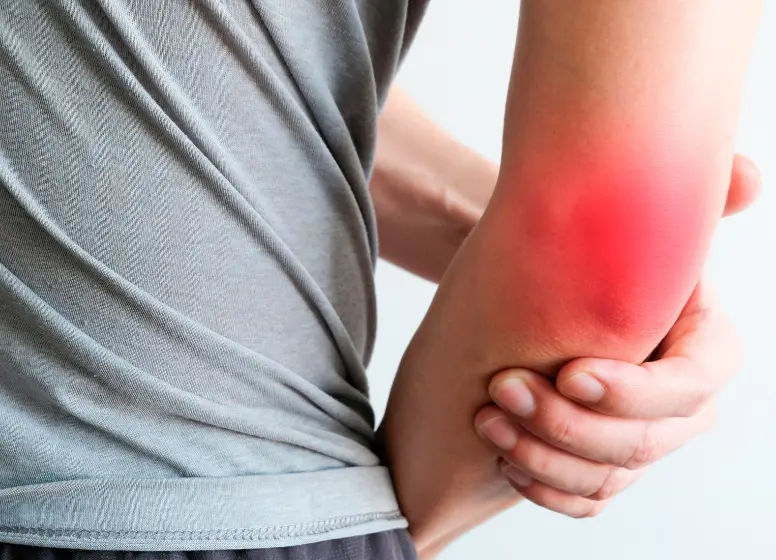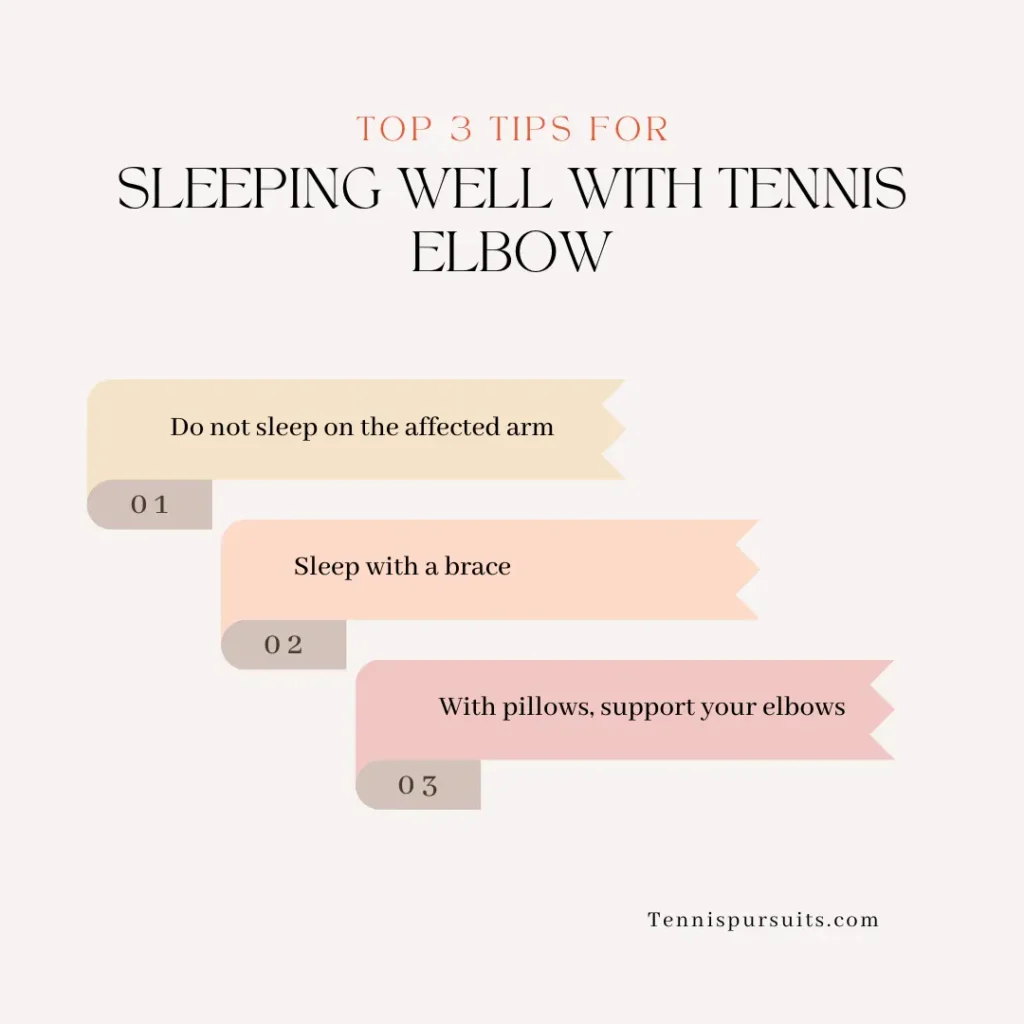Sleep is an essential part of our daily routine, providing rest and rejuvenation to our bodies. However, for individuals suffering from tennis elbow, a condition characterized by pain and inflammation in the elbow joint, getting a good night’s sleep can be challenging. In this article, we will explore effective strategies to help you sleep better with tennis elbow and wake up refreshed. let’s get started to know about how to sleep with tennis elbow.
What is tennis elbow?

Anyone who has experienced tennis elbow will know it is not enjoyable. Racquet sports in particular can lead to players experiencing injuries and niggles from time to time, unfortunately. One painful, and common injury is tennis elbow, which is a medical condition known as medial epicondylitis. Tennis elbow is caused by overuse or repetitive movements and occurs when tendons become overused, leading to inflammation and potential tearing. Whilst anyone can develop the condition from a variety of actions, it commonly affects sports players who grip their equipment too tightly or through repetitive motion putting too much pressure on the lateral epicondyle. Whether a sports player or not, anyone can develop this painful condition.
Pain from tennis elbow can stop people from playing sports, or even working, and if you’re experiencing pain at night, you’re not alone. This overuse injury associated with swelling and irritation of the tendons in the elbow causes painful symptoms while sleeping, or trying to get to sleep. In this article, we will give you some tips on the best way to sleep with tennis elbow, the best sleeping positions, and more ways you can help ease the pain at night time.
Also Read: How to clean tennis balls?
How to Fall and Stay Asleep with Tennis Elbow
In light of the fact that interrupted or lack of sleep can cause a host of other problems that negatively impact daily life, finding ways to rest is essential when dealing with this nagging condition. Trying a few options may help you determine what works best for you. Your doctor should be consulted if nothing seems to be working.
- Heat should be used before sleeping. Use a heated bath, hot compress, heating pad, or topical cream such as Bengay or Icy Hot before you go to bed to promote circulation and relaxation.
- A loose-fitting sleeve should be worn over the elbow. Opt for a light neoprene version instead of a tight brace or compression sleeve that restricts circulation. The loose support conserves heat and helps stabilize the forearm so tendons and muscles are not put under too much pressure.
- The elbow should be supported by a pillow. It is also helpful to add external support under your arm by placing a pillow under it.
- Lie on your back or on a side that is not affected. It sounds obvious, but it’s not always easy for people who sleep on their sides or stomachs. In addition, you may move around while asleep, which makes it impossible to fall asleep in a different position.
You may enjoy reading How to Volley in Tennis?
Tips on sleeping well with tennis elbow

There are a number of symptoms associated with lateral epicondylitis, or tennis elbow. There could be a reason for these symptoms keeping you up at night, and it might be the way you sleep. Sleeping better with lateral epicondylitis is possible thanks to a few steps you can take. Tennis elbow sufferers can benefit from these three tips for sleeping better:
Do not sleep on the affected arm
It is common for people to sleep on their sides, but this can be problematic for people who suffer from tennis elbow. Blood flow to injured tendons can be reduced by lying on the affected arm. Therefore, this can decrease the healing process during sleep. When you sleep on your back, however, you don’t put as much pressure on your elbow, which allows the blood flow to remain normal and boosts nocturnal healing.
Sleep with a brace
Lastly, tennis elbow braces can help you sleep better with tennis elbow. Supporting the forearm muscles, these braces fit slightly below the elbow and are worn on the forearm. They do this by reducing pressure on the injured elbow tendons, which helps reduce nighttime pain. When you typically clench your fists at night, these braces can help prevent your forearm muscles from contracting fully, which can help your tennis elbow.
With pillows, support your elbows
In spite of sleeping on your unaffected side, tennis elbow can still prevent you from getting a good night’s sleep. As a result of this position, your upper arm muscles place strain on your elbow, which can lead to elbow tendons being more painful.
Furthermore, if you twist your forearm while sleeping, you may stress the injured tendons further and result in pain. Tennis elbow sufferers can avoid such issues by supporting their affected arm on a pillow. As you sleep, you can untwist your forearm, which can relieve tension in upper arm muscles.
What’s the difference between a tennis elbow and golfer’s elbow?

Tennis elbow is a condition that commonly affects the outside of the elbow joint. Golfer’s elbow is a condition of the medial (inside) epicondyle tendon or inner part of the elbow. People with golfer’s elbows have inner elbow pain that moves down the arm. They can experience numbness and tingling sensations. Golfers can get tennis elbow pain, just as a tennis player may get a golfer’s elbow. For serious cases, a medical professional can give steroid injections to the affected area to help ease the pain.
Who might get tennis elbow?
Unfortunately, this can happen to anyone who performs repetitive activities that has a particular focus on the forearms, hands or wrists. Tennis elbow can happen to someone on a sports field or in a place of work:
- Tennis players
- Squash players
- Golfers
- Racquetball players
- Baseball players.
- Fencers
- Ice Hockey
- Golfers.
- Padel and Pickleball players
People who work in certain professions are also more prone to tennis elbow:
- Factory workers
- Mechanics
- Butchers
- Chefs
- Carpenters
- Plumbers
- Dentist.
- Gardeners
- Manicurist
- Musicians (drummers are particularly prone to it!)
How to get a decent sleep with tennis elbow?
We all want a decent night’s sleep. Sleeping positions that allow the arm to remain straight and for optimum blood flow to the tendons that encourage the healing process are recommended. Try sleeping on your back with your affected arm as straight as possible along your side. Use pillows or folded blankets to help keep your body and arm in position. Avoid applying pressure to the affected arm or moving your arm around too much. This will help reduce inflammation and swelling in the elbow.
Positions to Avoid When Sleeping
Do not sleep on your affected arm and do not bend the arm and hide under a pillow as example. By sleeping on your arm, the blood flow will be restricted. By stretching or bending your arm it can further aggravate the injury. If move around a lot in your sleep and struggle to keep your arm by your side try wearing a brace or a wrist splint that keeps it in place. It is also a lot harder to move around in one of these!
You may enjoy reading Best Creams for Tennis Elbow
Top Tips Improve Tennis Elbow at Night

The good news, there are some options for helping with sleep. Below are examples of nonsurgical treatments to try and remedy the pain at night.
Position – Try and keep your arm in a position that does not further aggravates the inflammation. For side and front sleepers, this is a bit of a problem since you usually sleep with your arms curled under your head or pillow. To avoid putting strain on your elbow while recovering, we recommend sleeping on your back and keeping your arm as straight as possible next to you in a relaxed position to help the injured area. One tip is to place a pillow under your arm which allows the arm to rest in an elevated position.
Hot or cold? – A cold pack or ice should be the first thing you apply upon experiencing pain, but note ice is not a long-term solution for relieving pain. Heat is a better remedy as it increases flow to the blood vessels in the affected area, the heat expands and then relaxes the muscle. Try putting a heating pad on the affected area for a short time before sleep.
Wear support – this is a good idea for anyone who is keen to carry on their daily activities. Our top tip is rest and to let the affected area recover. If this is not possible an elbow or a wrist brace will provide support and take some of the strain from the affected area. A supportive brace will not cure your tennis elbow but it will provide some support.
Pain cream – There are certain pain relief creams on the market that can ease the pain. By rubbing this into the affected area on the forearm muscles of the affected area, it may help ease pain whilst you try and sleep. Check with your pharmacist for recommendations.
Massage – Regular massage to the affected area can help with increasing blood flow to the area.
How can I prevent tennis elbow?
There are steps that can be taken to help prevent tennis elbow
Listen to your body. If you are in pain using your arm, you must stop. It is your body’s way of telling you. Pushing through the pain it can lead to more damage to your tendon and potential tearing.
Check your equipment – sometimes a heavy tennis racquet can cause tennis elbow, check your string tensions also. By doing the same action as before you will most likely continue to develop a tennis elbow.
Stretching – stretching wrists and arms before use is an effective way to help ease tennis elbow. We suggest strengthening the forearms and wrist muscles where possible to build up the muscles in the forearm.
Medical advice – If you are prone to tennis elbow, regular physical therapy with an occupational therapist can help manage this condition.
Braces – Wear a tennis elbow brace to keep symptoms from worsening.
Do not suffer in silence – Our view is always if pain does not go away consult a medical practitioner for expert advice. The advice above is to help manage the condition, we are not doctors with a magic cure!
Do not rush back – Recovery time is so important to let the inflammation recede. Do not rush back if you can avoid it!
Also, check Is Tiger Balm Good for Tennis Elbow?
Why Does My Elbow Hurt When Sleeping?
Repetitive motion has already injured the tendon, so degeneration is ongoing and does not require movement to cause irritation. Unfortunately, it just hurts.
Moreover, without treatment, tendons heal very slowly due to reduced blood supply and poor circulation. The lack of movement and lower circulation during resting can also lead to tightness and stiffness of muscles and connective tissues, particularly as we age.
Sleeping positions can also aggravate pain by adding strain to the arms and body. Rolling onto your forearm or twisting it can aggravate the injured area further if you sleep on the affected arm, extend your arms overhead, or sleep on the injured arm.
Can Pain Meds Or Liniments Help?
Certainly! Pain medications and liniments can provide relief for individuals experiencing tennis elbow. Here’s a closer look at how these treatments can help:
Pain Medications
Over-the-counter pain medications, such as nonsteroidal anti-inflammatory drugs (NSAIDs) like ibuprofen or naproxen, can help reduce pain and inflammation associated with tennis elbow. These medications work by inhibiting the production of certain chemicals in the body that contribute to pain and swelling. It’s important to follow the recommended dosage and consult with a healthcare professional or pharmacist before starting any new medication.
Pain medications can provide temporary relief, allowing you to sleep more comfortably. However, it’s important to note that they do not address the underlying cause of tennis elbow. Therefore, it’s advisable to combine their use with other self-care strategies and seek professional advice for a comprehensive treatment plan.
Liniments and Topical Analgesics
Liniments and topical analgesics are external treatments that are directly applied to the affected area. They often contain ingredients such as menthol, camphor, or capsaicin, which can provide a soothing or numbing effect. These products can help alleviate pain and provide temporary relief when applied as directed.
When using liniments or topical analgesics, it’s important to follow the instructions provided by the manufacturer. Apply a thin layer to the affected area and gently massage it in. Be cautious not to apply these products to broken or irritated skin, and discontinue use if you experience any adverse reactions.
While pain medications and liniments can offer temporary relief, it’s important to note that they are not a cure for tennis elbow. They can help manage the symptoms and provide short-term comfort, but long-term recovery may require additional interventions and lifestyle modifications.
In conclusion, pain medications and liniments can be helpful in reducing pain and discomfort associated with tennis elbow, allowing for a more restful sleep. However, it’s important to consult with a healthcare professional for a comprehensive treatment plan tailored to your specific needs.
FAQs
Can tennis elbow worsen with lack of sleep?
Lack of sleep itself does not directly worsen tennis elbow, but it can impact pain perception and overall recovery. Adequate rest and sleep are crucial for the body’s healing processes.
Are there specific pillows designed for tennis elbow?
There are ergonomic pillows available that provide targeted support to the neck, shoulder, and arm areas. These pillows can be beneficial for individuals with tennis elbow.
Is surgery always required for tennis elbow?
Surgery is typically considered a last resort for tennis elbow when conservative treatments fail to provide relief. Most cases can be managed effectively with non-surgical approaches.
Can sleeping on the affected arm aggravate tennis elbow symptoms?
Sleeping on the affected arm can increase pressure on the elbow joint and worsen symptoms. It is advisable to avoid putting direct weight or strain on the affected elbow while sleeping.
How long does it take to recover from tennis elbow?
Recovery time for tennis elbow varies depending on the severity of the condition and individual factors. In general, it can take several weeks to months with proper treatment and lifestyle modifications.
Final Thoughts
Tennis elbow can disrupt sleep and that leads to us being less effective at our everyday activities and normally grumpier. Try adjusting your sleep position, use ice to reduce inflammation, try heat treatment, and wear a brace if needed for extra support. Hopefully, this will lessen the symptoms of tendinitis, allowing you to finally lie back and catch some flies (*sleep – bad joke :).
Sometimes tennis elbow does not subside and a doctor may give you a physical exam or even send you for an MRI scan to double check there is nothing broken.
You may enjoy reading Can You Play Tennis With Tennis Elbow?




Comments are closed.